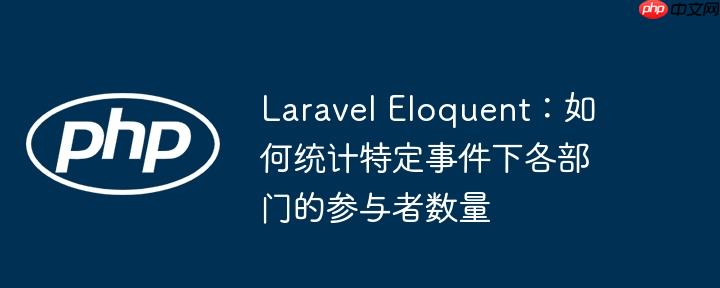
在处理复杂的关联数据统计前,清晰地理解数据模型及其关系至关重要。本教程涉及以下核心实体:
这些实体在数据库中通过以下方式关联:
对应的Laravel Eloquent模型关系定义如下:
Department 模型:
// app/Models/Department.php
use Illuminate\Database\Eloquent\Model;
use Illuminate\Database\Eloquent\SoftDeletes;
class Department extends Model
{
use SoftDeletes; // 如果使用了软删除
public function participants()
{
return $this->hasMany(Participant::class, 'department_id');
}
}Participant 模型:
// app/Models/Participant.php
use Illuminate\Database\Eloquent\Model;
use Illuminate\Database\Eloquent\SoftDeletes;
class Participant extends Model
{
use SoftDeletes; // 如果使用了软删除
public function department()
{
return $this->belongsTo(Department::class, 'department_id');
}
public function events()
{
// 定义与 Event 模型的多对多关系,通过 event_participant 枢纽表
return $this->belongsToMany(Event::class, 'event_participant', 'participant_id', 'event_id')
->withTimestamps(); // 如果枢纽表有 created_at 和 updated_at 字段
}
}Event 模型:
// app/Models/Event.php
use Illuminate\Database\Eloquent\Model;
use Illuminate\Database\Eloquent\SoftDeletes;
class Event extends Model
{
use SoftDeletes; // 如果使用了软删除
public function participants()
{
// 定义与 Participant 模型的多对多关系,通过 event_participant 枢纽表
return $this->belongsToMany(Participant::class, 'event_participant', 'event_id', 'participant_id')
->withTimestamps();
}
}在上述模型关系的基础上,一个常见的需求是统计每个部门在特定事件中的参与者数量。例如,我们可能需要获取“2023年年度峰会”中,每个部门有多少人参与。
直接使用 withCount('participants') 只能统计部门下所有参与者的总数,而无法根据事件进行筛选。例如:
use App\Models\Department;
$departments = Department::select(['departments.id', 'departments.name'])
->withCount('participants')
->orderByDesc('participants_count')
->get();
/*
可能的输出:
#DepartName #participants_count
department_A 120
department_B 80
department_C 50
*/这无法满足我们对特定事件进行过滤的需求。我们需要一种方法,在计算 participants_count 时,只考虑那些与指定事件关联的参与者。
Laravel Eloquent 提供了强大的 withCount 方法,它不仅可以简单地计数关联模型,还允许我们通过闭包(Closure)为其添加额外的约束条件。结合 whereHas 方法,我们可以实现对多层关联关系的复杂过滤。
whereHas 方法用于筛选那些“拥有”特定关联模型的父模型。在这里,我们需要筛选出那些“拥有”特定事件的参与者。
以下是实现特定事件下各部门参与者数量统计的查询代码:
use App\Models\Department;
// 定义要查询的特定事件名称或ID
$specificEventName = '2023年年度峰会'; // 假设我们通过事件名称来过滤
// 或者 $specificEventId = 1; // 如果通过事件ID来过滤
$departmentsWithEventParticipantsCount = Department::withCount([
'participants' => function ($query) use ($specificEventName) {
// 在participants关联查询中添加条件
// 筛选出那些关联到特定事件的参与者
$query->whereHas('events', function ($eventQuery) use ($specificEventName) {
// 在events关联查询中添加条件,根据事件名称进行过滤
$eventQuery->where('name', $specificEventName);
// 如果通过事件ID过滤,可以使用:
// $eventQuery->where('id', $specificEventId);
});
}
])
->orderByDesc('participants_count') // 按照参与者数量降序排序
->get();
// 遍历结果并输出
foreach ($departmentsWithEventParticipantsCount as $department) {
echo "部门名称: " . $department->name . ", 特定事件参与者数量: " . $department->participants_count . PHP_EOL;
}代码解析:
通过这种方式,participants_count 字段将只包含属于指定事件的参与者数量。即使某个部门在指定事件中没有参与者,它仍然会出现在结果集中,但其 participants_count 将为 0,这符合报表的需求。
期望的输出示例:
部门名称: department_A, 特定事件参与者数量: 5 部门名称: department_B, 特定事件参与者数量: 5 部门名称: department_C, 特定事件参与者数量: 0 部门名称: department_D, 特定事件参与者数量: 0 部门名称: department_E, 特定事件参与者数量: 0
Department::withTrashed()->withCount(['participants' => function ($query) {
$query->withTrashed()->whereHas('events', function ($eventQuery) {
$eventQuery->withTrashed()->where('name', '...');
});
}])->get();但通常情况下,默认行为(排除软删除)是符合业务逻辑的。
通过灵活运用 Laravel Eloquent 的 withCount 方法及其闭包约束,结合 whereHas 方法,我们可以高效且优雅地处理复杂的关联模型计数需求。这种方法不仅代码可读性强,而且能够充分利用 Eloquent 的强大功能,减少手动编写复杂 SQL 查询的工作量,是构建数据报表和统计功能的理想选择。掌握这些高级查询技巧,将极大地提升您在 Laravel 项目中处理复杂数据关联的能力。
以上就是Laravel Eloquent:如何统计特定事件下各部门的参与者数量的详细内容,更多请关注php中文网其它相关文章!

每个人都需要一台速度更快、更稳定的 PC。随着时间的推移,垃圾文件、旧注册表数据和不必要的后台进程会占用资源并降低性能。幸运的是,许多工具可以让 Windows 保持平稳运行。




Copyright 2014-2025 https://www.php.cn/ All Rights Reserved | php.cn | 湘ICP备2023035733号